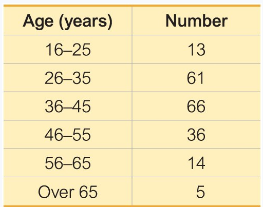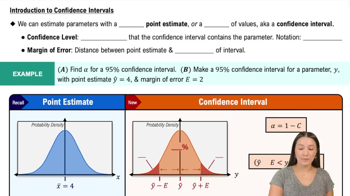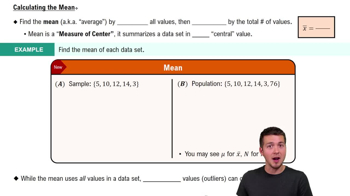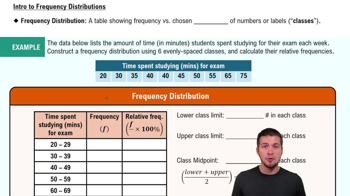For which of the following scenarios can you NOT create a confidence interval using the standard normal or t-distribution?
Table of contents
- 1. Intro to Stats and Collecting Data1h 14m
- 2. Describing Data with Tables and Graphs1h 55m
- 3. Describing Data Numerically2h 5m
- 4. Probability2h 16m
- 5. Binomial Distribution & Discrete Random Variables3h 6m
- 6. Normal Distribution and Continuous Random Variables2h 11m
- 7. Sampling Distributions & Confidence Intervals: Mean3h 23m
- Sampling Distribution of the Sample Mean and Central Limit Theorem19m
- Distribution of Sample Mean - Excel23m
- Introduction to Confidence Intervals15m
- Confidence Intervals for Population Mean1h 18m
- Determining the Minimum Sample Size Required12m
- Finding Probabilities and T Critical Values - Excel28m
- Confidence Intervals for Population Means - Excel25m
- 8. Sampling Distributions & Confidence Intervals: Proportion1h 12m
- 9. Hypothesis Testing for One Sample3h 29m
- 10. Hypothesis Testing for Two Samples4h 50m
- Two Proportions1h 13m
- Two Proportions Hypothesis Test - Excel28m
- Two Means - Unknown, Unequal Variance1h 3m
- Two Means - Unknown Variances Hypothesis Test - Excel12m
- Two Means - Unknown, Equal Variance15m
- Two Means - Unknown, Equal Variances Hypothesis Test - Excel9m
- Two Means - Known Variance12m
- Two Means - Sigma Known Hypothesis Test - Excel21m
- Two Means - Matched Pairs (Dependent Samples)42m
- Matched Pairs Hypothesis Test - Excel12m
- 11. Correlation1h 6m
- 12. Regression1h 50m
- 13. Chi-Square Tests & Goodness of Fit1h 57m
- 14. ANOVA1h 57m
7. Sampling Distributions & Confidence Intervals: Mean
Confidence Intervals for Population Mean
Problem 7.2.33
Textbook Question
Ages of Prisoners The accompanying frequency distribution summarizes sample data consisting of ages of randomly selected inmates in federal prisons (based on data from the Federal Bureau of Prisons). Use the data to construct a 95% confidence interval estimate of the mean age of all inmates in federal prisons.

 Verified step by step guidance
Verified step by step guidance1
Step 1: Calculate the midpoint for each age group. The midpoint is the average of the lower and upper bounds of each age group. For example, for the age group 16–25, the midpoint is (16 + 25) / 2 = 20.5.
Step 2: Multiply the midpoint of each age group by the corresponding frequency (number of inmates) to find the weighted contribution of each group to the total sum. For example, for the age group 16–25, the contribution is 20.5 × 13.
Step 3: Sum up all the weighted contributions from Step 2 to calculate the total sum of ages. Also, sum up all the frequencies to find the total number of inmates.
Step 4: Divide the total sum of ages by the total number of inmates to calculate the sample mean age. This is the point estimate for the mean age.
Step 5: Use the formula for the standard error of the mean (SE = s / √n, where s is the sample standard deviation and n is the sample size) and the t-distribution to construct the 95% confidence interval. The confidence interval is given by: Mean ± (t * SE), where t is the critical value from the t-distribution table for 95% confidence and degrees of freedom (df = n - 1).
 Verified video answer for a similar problem:
Verified video answer for a similar problem:This video solution was recommended by our tutors as helpful for the problem above
Video duration:
5mPlay a video:
Was this helpful?
Key Concepts
Here are the essential concepts you must grasp in order to answer the question correctly.
Confidence Interval
A confidence interval is a range of values, derived from sample statistics, that is likely to contain the true population parameter. For example, a 95% confidence interval suggests that if we were to take many samples and construct intervals in the same way, approximately 95% of those intervals would contain the true mean. This concept is crucial for estimating population parameters based on sample data.
Recommended video:

Introduction to Confidence Intervals
Mean
The mean, or average, is a measure of central tendency that is calculated by summing all values in a dataset and dividing by the number of values. In the context of the ages of prisoners, the mean age provides a single value that represents the central point of the age distribution, which is essential for constructing the confidence interval.
Recommended video:
Guided course

Calculating the Mean
Frequency Distribution
A frequency distribution is a summary of how often each value occurs in a dataset. In this case, the table shows the number of prisoners within specific age ranges. Understanding frequency distributions is important for analyzing data, as it helps identify patterns and informs the calculation of statistics like the mean and confidence intervals.
Recommended video:
Guided course

Intro to Frequency Distributions

 4:48m
4:48mWatch next
Master Population Standard Deviation Known with a bite sized video explanation from Patrick
Start learningRelated Videos
Related Practice
Multiple Choice
